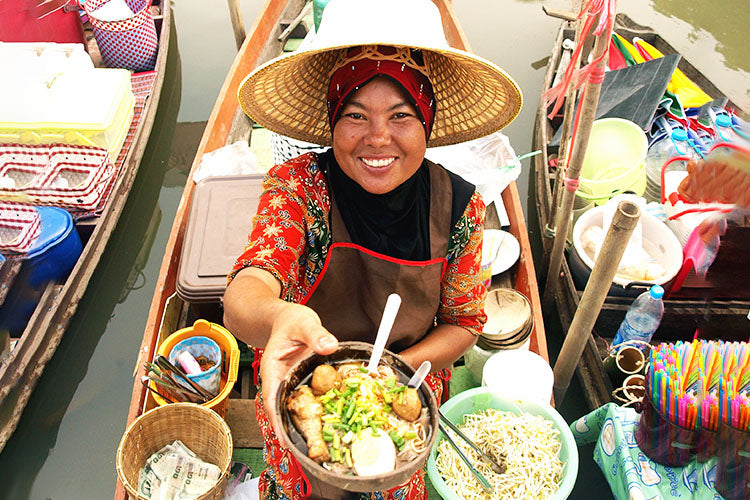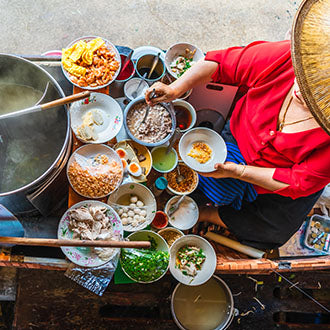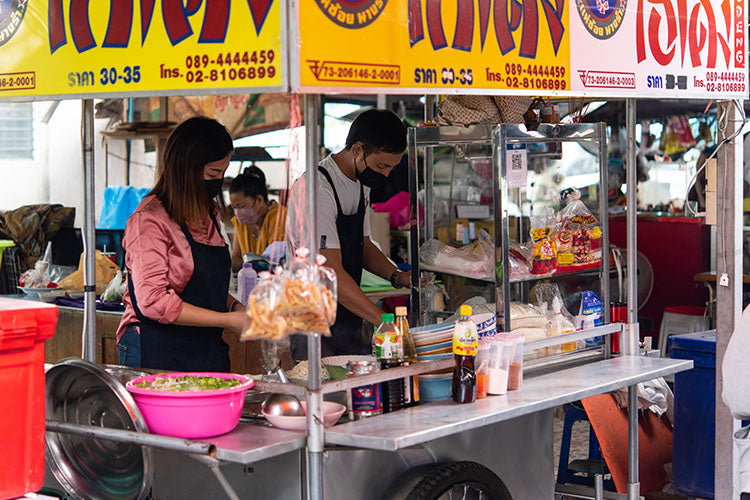My shopping cart
Your cart is currently empty.
Continue Shopping
Thai noodle soup is a popular food in Thailand and is recognized for its filling, soothing qualities as well as its wide variety. It can be enjoyed at any time of the day, from a hearty breakfast to a late-night snack. They are not only a staple in Thai households but are also commonly found in street food stalls, local markets, and high-end restaurants across the country.
Whether you're a fan of fiery Tom Yam or the milder Guay Teow Nam Sai, Thai noodle soups offer something for everyone. The term “ก๋วยเตี๋ยว (Guay Teow)” or Thai noodle soup encompasses a wide variety of dishes, each with its own distinct set of ingredients and preparation methods. While some are steeped in centuries-old traditions, others are influenced by neighboring countries, resulting in an exciting array of flavors and textures.
Despite their differences, all Thai noodle soups share a common foundation - a fragrant broth, tender noodles, and a medley of toppings that bring depth and complexity to each bowl.

The ingredients used in Thai noodle soups are what gives them their distinct flavors. The base of any Thai noodle soup is the broth, typically made from boiling pork or chicken meat or bones for several hours.
Some recipes may also call for the addition of fish sauce, soy sauce, or fermented shrimp paste to enhance the savory flavor of the broth. The noodles used in these soups can vary greatly, from thin rice noodles to thicker wheat or egg noodles. The choice of noodle often depends on the specific dish and personal preference.
Regardless of the type, the noodles are cooked until tender and then served in the hot broth. Toppings are an essential component of Thai noodle soups, adding layers of flavor and texture to each bowl.
These can range from slices of meat or tofu to vegetables like bean sprouts, bok choy, and water spinach. To finish, the soups are garnished with fresh herbs such as cilantro, basil, and green onions, and served with a side of lime wedges, chili flakes, and sugar for adjusting the flavor to one's liking.
There are so many types of noodle soup dishes in Thailand, but here are some of the most popular ones you should try in Thailand.

Tom Yam, known for its robust and tangy broth, takes on a new form in noodle soup. The classic ingredients like lemongrass, kaffir lime leaves, galangal, and Thai chilies infuse the broth with a harmonious balance of heat and tanginess.
Fragrant rice noodles absorb the flavors while succulent shrimp or tender chicken add depth to the dish. This soup is often garnished with fresh cilantro, scallions, and a squeeze of lime, providing a burst of freshness with every spoonful.
Originating from Northern Thailand, Khao Soi is a unique noodle soup that marries the flavors of a rich, coconut-based curry with crispy egg noodles.
The result is a multi-dimensional dish where the velvety curry broth coats the noodles and tender meat, creating a symphony of flavors and textures. Toppings like shallots, lime wedges, pickled mustard greens, and roasted chili paste allow you to customize each bite to your preference.

For a Thai-Chinese influenced taste, Boat Noodle Soup is a must-try. Originally sold from boats along the canals of Bangkok, this dish is characterized by its intensely flavored, dark, and aromatic broth.
Herbs, spices, and a blend of pork and beef form the foundation of the soup, while small, delicate rice noodles soak up the savory essence. A variety of condiments, such as ground peanuts, chili flakes, and bean sprouts, lend depth and complexity to the dish.
Ba Mee Moo Daeng showcases the beloved combination of egg noodles and succulent slices of barbecued pork. The noodles are typically served in a clear broth alongside the char siu pork, creating a contrast between the mild, clean flavors of the broth and the rich, slightly sweet taste of the pork.
Don't forget to add a dash of vinegar and chili sauce to awaken your taste buds.

For the adventurous eater, Guay Jab offers a unique experience. This noodle soup features rolled rice noodles swimming in a hearty pork broth, often infused with a medley of pork offal, such as intestines and liver.
The broth's deep umami flavor is complemented by garlic, white pepper, and aromatic herbs. It's a dish that showcases Thailand's commitment to using every part of the animal in their culinary creations.

If you are in Thailand and want to order and eat noodle soup but not sure how, here are some guidelines: How to order: Most noodle dishes in Thailand can be customized to your liking. The typical stall or restaurant will usually have a list of ingredients for you to choose from. Normally you can start from choosing types of noodles: rice noodles, egg noodles, or vermicelli.
Follow by choosing the soup or broth, typical soups are clear soup, Tom Yam, or Kuay Teow Reua. Adding vegetables, and meat of your choices, from chicken, beef, pork or seafood. You can also select other toppings or seasoning, such as no sugar or chilli flakes. So don’t be shy to ask for what you like or skip what you don’t like. Also, you can also ask for more noodles, meat or vegetables, with a very little extra charge. How to eat: Noodle soup is generally served in an individual bowl. Thais usually start by sampling and adjusting the noodles to their liking by adding chili flakes, sugar, fish sauce, or vinegar.
When eating noodle soup, Thais use chopsticks and a soup spoon. Chopsticks will be held in the dominant hand, and a spoon in the other. Grab a small amount of noodles and pull them out of the soup, then eat directly from the chopsticks or place them in the spoon before eating. You can add a small amount of noodles, meat, vegetables and broth in the spoon, a good way to mix everything for a perfect bite and a good technique for eating if the food is still too hot and to avoid soup splashes on your clothes.

Making Thai noodle soups at home is quite easy, especially if you make a clear noodle soup. Begin by preparing the broth. This typically involves simmering meat or bones (popular choices are chicken, pork or beef) with aromatics like lemongrass, galangal, and kaffir lime leaves until a flavorful broth is achieved.
While the broth is simmering, prepare the noodles according to the package instructions. Once cooked, divide them among serving bowls and set aside. Next, prepare your chosen toppings. This could involve thinly slicing meat or tofu, chopping vegetables, or pickling some mustard greens. When the broth is ready, strain it to remove the solids and return it to the pot.
Adjust the flavor with fish sauce, sugar, and lime juice until you achieve a balance that suits your palate. Ladle the hot broth over the noodles, top with your prepared toppings, and garnish with fresh herbs. Serve immediately with lime wedges, chili flakes, and sugar on the side for additional seasoning.